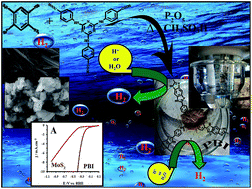Polybenzimidazole and polybenzimidazole/MoS2 hybrids as an active nitrogen sites: hydrogen generation application
Abstract
Development of free metal or non-noble-metal catalysts for electrode materials with both excellent activity and high stability is essential for hydrogen production. In this work, nitrogen rich polybenzimidazole (PBI) networks were synthesized through a one-step polycondensation of 1,2,4,5-tetraaminobenzene with 4,4′,4′′-((1,3,5-triazine-2,4,6-triyl)tris(azanediyl))tribenzoic acid. Then, organic/inorganic nanohybrids of PBI with amorphous MoS2 nanoplates (PBI–MoS2) were prepared. The structural characterization and morphological of these novel hybrids were studies using FT-IR, 1H NMR, elemental analysis, thermogravimetry, transmission electron microscopy, field-emission scanning electron microscopy and X-ray diffraction techniques. Electrochemical studies revealed the onset potential of only (−160 mV vs. RHE) with a small Tafel slope of 50.6 mV dec−1 for hydrogen generation reaction in 0.5 mol L−1 H2SO4. Stability tests through long term potential cycles confirm the excellent durability of PBI–MoS2 in acid media. The outstanding hydrogen generation activity is derived from the electronic penetration effect and H+ absorption of pyridinic-N and/or pyrrolic-N as active sites at per repeat of the PBI matrix. It is worth noting that pure PBI and PBI–MoS2 hybrids, for the first time, were used as both anode and cathode in two-electrode system open up new possibilities for exploring overall hydrogen generation technology catalysts in acidic electrolyte. This development offers an attractive electrocatalyst for large-scale hydrogen generation.


 Please wait while we load your content...
Please wait while we load your content...